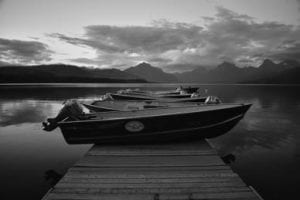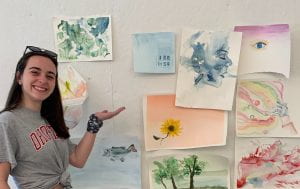For my STEP signature project, I attended the Leigh Howard Stevens Summer Marimba Seminar. This two-week seminar focused on marimba technique, musicianship, baroque performance practice, Japanese marimba literature, audio and video engineering, and ragtime xylophone. Not only did we learn from Leigh Howard Stevens, the creator of the Stevens technique (which most western percussionists use to play four-mallet marimba), but we also got instruction from John Parks IV (audio and video engineer as well as professor at Florida State), Michael Burritt (Composer, performer, and teacher at the Eastman School of Music), Bob Becker (Re-discoverer of ragtime xylophone, founder of NEXUS percussion, and “greatest xylophonist alive”), and Yurika Kimura (President of PAS society in Japan, student of Keiko Abe). When I initially arrived in Ocean Grove, New Jersey, I truly thought that I would return home with new knowledge on technique and musicianship for the marimba; however, what I returned home with was not only technique and musicianship, but also a new passion for music.
The first week, half of the seminar, Leigh Howard Stevens (LHS) solely lectured us on four-mallet marimba technique. While this may seem excessive to non-musicians and musicians alike, this monomaniacal focus on technique was extremely valuable. The Stevens technique is relatively new (only 50 years old). This, combined with the fact that most secondary schools do not have qualified teachers teaching their students correct technique, leads to utter disaster. It is not an understatement for me to say that I was utterly appalled by the number of participants who were misinformed or just uninformed about different aspects of the technique. By getting to learn all the aspects of Stevens technique from the creator himself, I not only corrected two aspects of my technique (minuscule compare to others), but I also became aware of the importance of technique. Technique is the basis for musicianship and performance. If I have a musical idea that I want to implement into one of my pieces, but I do not have the technique to do it, then it is impossible to execute. This concept of the importance of technique for marimba playing had never made sense to me until this seminar. Now, I plan to focus on improving my technique so that I can execute my musical creativity more effectively in performances.
During this first week, we also got to spend time with Dr. John Parks IV from Florida State University. He spent a whole day lecturing on audio and video engineering for prescreening videos (audition videos for graduate programs as a preliminary round to physical auditions). Twenty minutes into his lecture I felt like a complete and utter idiot. Less than a week before the seminar, I had sent in an audition video for a competition. After twenty minutes, I knew I would not get accepted. Literally everything he said to do I did not do, and everything he said not to do, I did. Anyway, I learned so much from Dr. Parks in his lectures. He told us what audio gear to buy, how we did not need to buy video gear since iPhone cameras are acceptable quality, how to stage the camera and set, how to set up the microphones and where to place them, what to wear, and how to use different software for the best results. My mind was blown after these lectures and I will never make an audition video the same ever again.
On the final day of the first week, we got to see Michael Burritt in performance. This moment was the most substantial moment of the trip. Watching Burritt perform for the first time was stunning – I literally cried. I was so taken with how he played and what repertoire he had chosen to perform. He not only performed classical literature like Bach’s Adagio from Sonata in G minor, but he also played pieces with electronic recordings like his new composition, The Fragile Corridor. This openness to electronics and new music was a huge game-changer for me – seeing as most classical musicians are not for electronics in music. After the performance, I knew that I wanted to go to Eastman School of Music for my masters to study under Michael Burritt – a huge change in my mindset considering I had no idea where I wanted to study before this.
The next week, Leigh Howard Stevens taught us about Baroque performance practice and musicianship. These lectures consisted of seminar attendees performing pieces by Bach, and LHS critiquing their performance. He was harsh. Almost after all of the performances, LHS would go on a ten minute rant about how the performer was uninformed of the Baroque style, had bought incorrect copies of the music (very easy to do if you know nothing about Bach’s music), and displayed poor musicianship throughout their performance. While he was ruthless with his critiques, they were needed. Being uneducated in the performance practices from the era of a piece is horrible. It not only shows immaturity as a musician, but also a lack of knowledge in the field. While I may personally not want to be a Bach expert like LHS, I found his information about Baroque performance practice translating to other styles and pieces as well. The topic that most stuck with me was his lecture about how Bach’s music is all about conversation. As LHS said, “Its not hard music on the surface. What makes Bach hard is distinguishing between the polyphony in the different musical lines – even if it looks like a singular line on the page.” This comment about finding the moving lines in a piece of music that may look monophonic directly related to a piece that I am working on, Spiral 1. In this piece, the music on the pages is very linear; however, if the performer focuses on bringing out the last note of the preceding line and first note of the next, there is a beautiful descending line that is occurring. Simply doing this adds interest and depth to the performance. This concept is useful in almost all pieces and is something that is my focus.
On Wednesday, Bob Becker and Yurika Kimura gave lectures on ragtime xylophone and Japanese marimba literature. While Bob Becker was amazing and gave a great lecture, I already knew everything he talked about because of my professor at Ohio State, Dr. Powell. She, like Becker, is a master xylophone player (personally I think she is better that Becker, but that is an opinion) so I had already been lectured on this topic by her. However, I had no knowledge on Kimura’s topic of Japanese marimba literature. Every time I had listened to Japanese marimba literature being played live or on recordings, it always sounded loud, aggressive, ugly, and angry. For this reason, I did not like it. Kimura told us that this interpretation was wrong. Japanese marimba music is meant to display the flow of emotions in a human being. While it does have angry sections, there are also sad, melancholy, happy, and nostalgic parts – the performer just has to perform it correctly. Kimura played part of a piece as an example and my mind was blown. The piece was so beautiful that I wondered why I had never performed this type of music before. After this lecture, I decided I would learn a piece of Japanese marimba literature.
The next day, Bob Becker and Yurika Kimura did a joint concert. This concert was a fun, enjoyable concert – a big change from the Bach we had been hearing all week. For the concert, Kimura performed Japanese marimba music for the first half, and the second half consisted of Bob Becker playing ragtime xylophone while Kimura played the four-piece accompaniment all on her own (VERY impressive). This performance aided my newfound mindset in two ways. One, it solidified my decision to perform Japanese marimba literature – Kimura’s performances just sealed the deal. Two, to focus on marimba study. When Becker and Kimura performed together, I could not focus on Becker at all. Kimura kept my attention the entire time. This just further instilled in me my love for marimba and the decision that I should focus on perfecting my marimba performance.
For the final day of the seminar, there were two performances. The first was a performance by the seminar participants for the people at the nursing home (where we had held our lectures and classes). This was probably the most fun I had at the seminar. My friend Amelia and I’s duet, Merge by Zachery Koors, was picked as the final performance on the concert – pretty awesome considering we learned and put the piece together while at the seminar. Not only did I get to hear my peers perform some cool pieces, but Amelia and I had the best run of our duet ever! When we finished performing, LHS came up to us and complimented our performance, asked who had written the piece, and then went on to say it sounded very much like Ivan Trevino’s compositions – a huge compliment considering Ivan Trevino is a big-name composer in the percussion world. This just made Amelia and my day. Earlier that week, we had been told by one of our peers that “LHS is going to hate this.” It was a nice moment of redemption. The second performance was by Leigh Howard Stevens. IT WAS BEAUTIFUL. Ironically, my favorite piece was the hymnal he played for the encore – What can I say? I’m just a sucker for chorales. Anyway, his sound on the instrument was so pure and resonant, it left me speechless. Unlike the other performances, I left this one with an introspective demeanor about me. His playing is almost like a religious service. The listener leaves it pondering about what was said. It was a great ending to the seminar because it left us, the seminar participants, contemplating. It was heavenly.
The Leigh Howard Stevens Summer Marimba Seminar was life changing. At the beginning, I thought I would leave this seminar with better technique and musicianship, but I left with so much more. I left this camp with a newfound love for Japanese marimba literature, a desire to go study at Eastman under Michael Burritt, common sense regarding audio and video recording, and a love for the marimba that had always been there, just not put into words. As Leigh Howard Stevens said, “You all play this instrument for a reason, you just have to figure out what drew you to it in the first place.”

Seminar participants in class

Picture of LHS with seminar participants



















